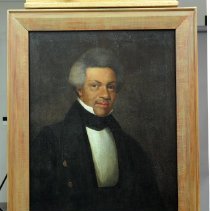Object Record
Images


Metadata
Object Name |
Portrait |
Title |
Dennis Doram, Jr. |
Catalog Number |
2000.29.1 |
Creator |
Davenport, Patrick Henry |
Date |
1839 |
Material(s) |
Paint/Canvas/Wood |
Dimensions |
H-29.25 W-23 D-0.75 inches |
Description |
This portrait is a bust view of Dennis Doram Jr. It is an oil painting on canvas in a plain wooden frame which has a faint red tiger stripe grain. The painting has a dark back ground. Doram is wearing a dark suit with a white shirt and dark cravat of the 1840s style. His hair slightly graying. Inscriptions on back "Dennis Doram aged 43 years painted by PH Davenport 1839" |
Notes |
Dennis Doram was born enslaved in 1796 at Indian Queen Tavern, the estate of Thomas Barbee in Danville, Kentucky. His mother Lidia was aslo enslaved, the daughter of Barbee and one of the women he enslaved. It is believed that Dennis's father was an Indian. Barbee's 1797 will freed Doram's mother and made accommodations for the freedom of all six of Lidia's children when they reached adulthood. The will also specified that Dennis and his brothers would be provided with an education in reading, writing, and arithmetic. Dennis received his freedom in the 1820s. Dennis's freedom and chance at an education provided him with the opportunity to succeed. He founded several businesses including a rope and hemp factory and proved to be civic minded, as he helped establish the Caldwell School for Women. Dennis married Diademia Taylor in 1830. Diademia was born in 1810. Her father was a free black man who had purchased her and her mother Chole's freedom for $700 in 1814, and had brought them from St. Louis to Kentucky. The Dorams had at least two sons. One, Joshua, was a Union soldier with Co. F, 114th USCT who fought in Petersburg campaign, and the other was a Buffalo Soldier in the Indian Wars after the Civil War. By the 1840's the Dorams had prospered like very few other African Americans in South. They had accumulated several thousands of dollars in the bank and possessed hundreds of acres of land. The portraits show above illustrate the unique social position the Dorams had attained. Images such as these for African Americans in the antebellum period are very rare. In March of 1866 Dennis served on the finance committee for the First Convention of Colored Men of Kentucky. He and the committee drafted a very strong and intelligent statement of intentions and a number of proclamations at this meeting. The following is a short excerpt of one such statement: "We are native and to the manner born; we are part and parcel of the Great American body politic; we love our country and her institutions; we are proud of her greatness and glory in her might; we are intensely American, allied to the free institutions of our country by sacrifices, the deaths and the slumbering ashes of our sons and our fathers, whose patriotism, whose daring and devotion, led them to pledge their lives, the property and their sacred honor, to the maintenance of her freedom, and the majesty of her laws. Here we are intended to remain, and while we seek to cultivate all of those virtues that shall distinguish us as good and useful citizens, our destiny shall be that of earnest and faithful Americans, and we recognize no principle, we allow no doctrine that would make our destiny, other, than the destiny of our native land and fellow countrymen." These two portraits are believed to be the only paintings of African Americans done by Patrick Henry Davenport who mainly worked in Kentucky, Indiana and Illinois. The Kentucky Historical Society also has portraits by Davenport of Mrs. Isaac Shelby, the wife of the first Governor of Kentucky, and the Abolitionist John Brown. |
Collection |
Kentucky Historical Society Foundation Collection |
People |
Davenport, Patrick Henry Doram, Dennis, Jr., 1796-1869 |
Subjects |
African-American African Americans Slavery Slaves Freedmen Businessmen Business people Portrait paintings Portraits |
Search Terms |
African Americans Danville (Ky.) |
Physical Holder |
Kentucky Historical Society - KHS |